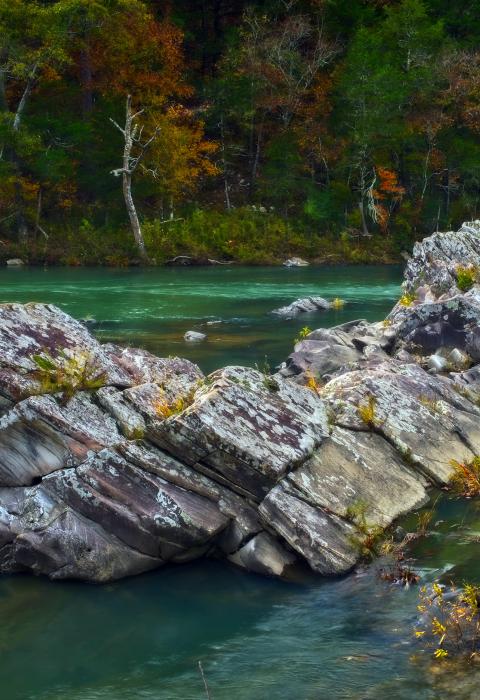Cossatot River
Arkansas
The stream heads up in rugged Ouachita mountain country, just southeast of Mena. It flows in a southerly direction for about 26 miles before its current ceases at Gillham Lake. Along the way, the Cossatot travels through the Ouachita National Forest, alongside a wilderness area, and over and around upended layers of jagged bedrock. This last characteristic is what gives the stream its Class IV/Class V rating among river-runners. The Cossatot, however, is not just for floaters. In fact, much of its whitewater is not recommended for casual canoeists. The stream offers something for nearly everyone interested in Arkansas's outdoors.
Designated Reach
April 22, 1992, and January 14, 1994. The segment of the Cossatot River from the confluence with Mine Creek in Polk County, near the town of Shady, Arkansas, downstream to Duchett's Ford, 4.6-miles below the State Highway 4 Bridge. Also, the segment of Brushy Creek from approximately 4.4 miles upstream of the Ouachita National Forest boundary just north of State Highway 246 to its confluence with the Cossatot River in the Cossatot River State Park-Natural Area in Polk County.
Outstandingly Remarkable Values
Fish
The most common fish caught are spotted and smallmouth bass, bream, and goggle-eye. Segments of the river are given a distinctive rating for the strong presence of the leopard darter, which are found in the 2.3-mile segment of the river extending upstream from the Highway 4 bridge.
Geology
As the Cossatot River flows southward, it cuts through the Ouachita Mountains, the Fourche Mountains, and the Athens Piedmont Plateau before it enters the West Gulf Coastal Plain. The rivers substrate (sediment) consists mostly of bedrock, rubble, and boulders. The principle geologic formation in the park-natural area is the Stanley Shale, which is composed of hard, fine-grained quartzite, sandstone, and hard siliceous shales of late Mississippian to early Pennsylvanian Age. Eons of downcutting through this formation have produced a rugged narrow canyon with steep side slopes.
Recreation
The National Park Service describes it as "probably the most challenging" white-water float in the state. The U.S. Army Corps of Engineers is a little more emphatic, saying it "is the most difficult whitewater stream in the state of Arkansas." Early Indians simply called it Cossatot—their word for "skull crusher." Today, the Cossatot River is still crushing things, but they're mostly canoes, ice chests, and the egos of over-confident paddlers.
Scenery
The scenic values are characterized by a free-flowing stream, steep, rocky bluffs and the absence of roads and other evidence of man. Scenery includes unique exposures to numerous sandstones, shale and novaculite formations, natural forest communities, and pastoral lands.

